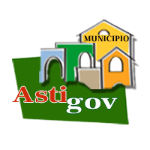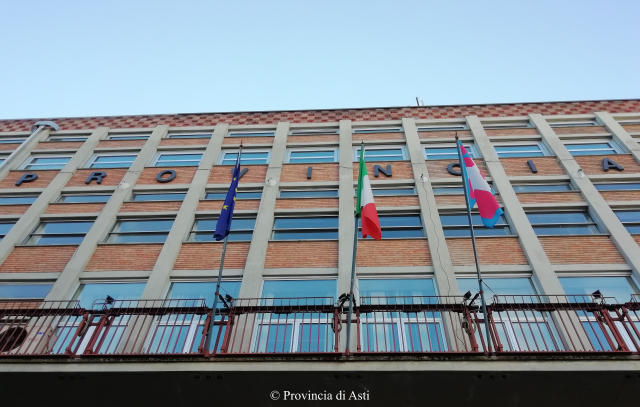Provincia di Asti
Last update 31 January 2024
The province of Asti, the golden bunch of Piedmont
Landscape
The territory of the province of Asti covers an area of about 160,000 hectares.
Insights
“La Provincia di Asti”. Provincia di Asti, Nov. 24, 2017, www.provincia.asti.it/it/page/la-provincia-di-asti. Last accessed Jan. 29, 2024.
History
The Provincia di Asti, established in 1935, has 117 municipalities (data updated to the year 2023).
Administration
Food and wine and typical products
The largest number of economic activities in the province of Asti are engaged in agriculture, manufacturing, and trade.
Viticulture is a source of pride for the Asti area: the finest DOC and DOCG wines are produced here.
The presence of the food industry is also important, both in the transformation activity and in the processing of typical local products.
The automotive and electromechanical industries, represented mainly by small or medium-sized enterprises, are well established in the Asti area.
Particularly relevant is the economic importance represented by the construction industry and handicrafts.
The Astigiano is increasingly establishing itself as a privileged tourist destination, and this affirmation is reflected in the constant growth of the commercial, hotel, and restaurant sectors.
Insights
“La Provincia di Asti”. Provincia di Asti, Nov. 24, 2017, www.provincia.asti.it/it/page/la-provincia-di-asti. Last accessed Jan. 29, 2024.
To be seen
On June 22, 2014, the wine-growing landscapes of Langhe-Roero and Monferrato were inscribed on the UNESCO World Heritage List.
Lands of extraordinary beauty that more and more tourists, including foreigners, want to visit and live in.
Food and wine excellence are accompanied by the wonders of Nature, often still uncontaminated, and a historical-artistic heritage of absolute appeal.
The Astigiano is a land of fine grape varieties such as Moscato, Barbera, Grignolino, Nebbiolo and Dolcetto, which give rise to wines with inimitable aromas.
Among the typical products we remember, without claiming to be exhaustive: the hunchback thistle of Nizza Monferrato, the “square” pepper of Asti, the asparagus of Vinchio, the “Divina” apple of San Marzano Oliveto, the “Mora” cherry of Revigliasco d'Asti, the peaches of Refrancore, the Robiola of Roccaverano, the amaretti of Mombaruzzo, the “round and gentle” hazelnut from Piedmont, cured meats and beef from the Piedmontese breed, and, of course, the diamond of the table, the white truffle.
Speaking of jewels, the Province of Asti also has its own, and it is the Campeggio di Roccaverano (Roccaverano Campsite), a summer camp for minors in the heart of the Langa of Asti.
Finally, a special mention goes to Asti, the provincial capital, which attracts tourists from all over the world thanks to celebrated events such as the Palio di Asti and the Festival delle Sagre.
Festivals and fairs characterize the ever-rich calendar of events hosted in the 117 municipalities of the Astigiano at any time of the year.
Insights
Douja d'Or 2023, www.doujador.it. Last accessed Jan. 29, 2024.
“La Provincia di Asti”. Provincia di Asti, Nov. 24, 2017, www.provincia.asti.it/it/page/la-provincia-di-asti. Last accessed Jan. 29, 2024.
“Palio di Asti”. Visit Asti | Feeling Good, visit.asti.it/settembre-astigiano/palio-di-asti. Last accessed Jan. 29, 2024.
Curiosity
On the site now occupied by the Palace of the Provincia di Asti, the Prefecture and the former Department of Finance (formerly Casa del Fascio) once stood the Boarium Forum, called the Alla.
Data source
- Synthesis / reprocessing information taken from the institutional website (current and previous versions) of the Provincia di Asti — https://www.provincia.asti.it
- Cover image source: Provincia di Asti — https://www.provincia.asti.it
Insights
BeWeb - Beni Ecclesiastici in WEB
https://beweb.chiesacattolica.it/
Catalogo Generale dei Beni Culturali
https://catalogo.beniculturali.it/
Centro Interuniversitario di Storia Territoriale "Goffredo Casalis"
https://www.archiviocasalis.it/
Ente Turismo Langhe Monferrato Roero
https://www.visitlmr.it
GAL Basso Monferrato Astigiano
https://www.monferratoastigiano.it/
la Cabalesta: Colline dell’arcobaleno
https://lacabalesta.it/
Wikipedia, l'enciclopedia libera.
https://it.wikipedia.org
- Provincia di Asti
https://it.wikipedia.org/wiki/Provincia_di_Asti
See also
News from the Provincia di Asti
- Discover the latest news posted on the website of the Provincia di Asti
https://www.provincia.asti.it/it/news
Events of the Provincia di Asti
- Discover the events posted on the website of the Provincia di Asti
https://www.provincia.asti.it/it/events
Social network | Provincia di Asti
Follow your Municipality on social media:
- Facebook: https://www.facebook.com/provinciadiasti/
- Instagram: https://www.instagram.com/provinciadiasti/
- YouTube: https://www.youtube.com/user/provinciadiasti

